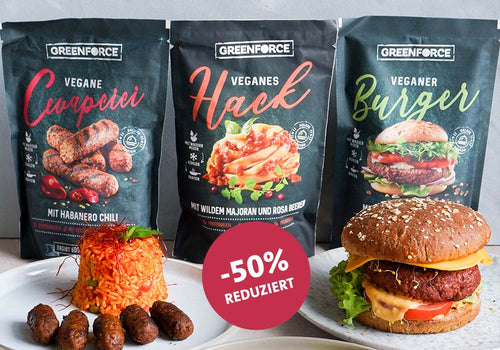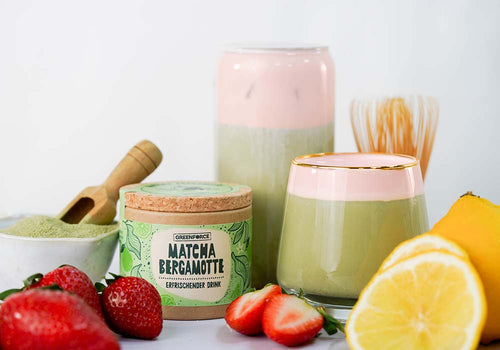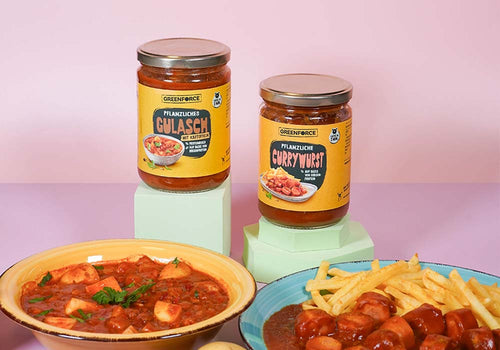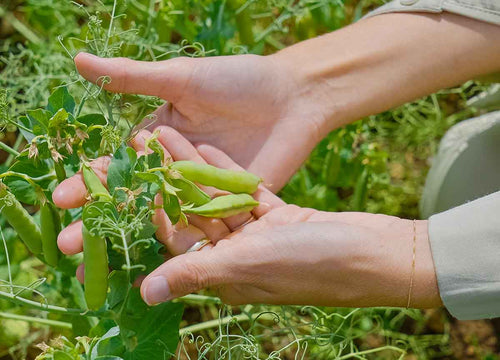Wheat allergy symptoms: which are typical?
Theresa Aicher
01/06/23
Reading time: 8 minutes
Food intolerances and allergies occur relatively frequently, sometimes only in adulthood. An allergic reaction is particularly common after eating wheat products. You can find out which symptoms indicate wheat allergies and what you can do about it with the right diet in our blog post.
Find out about the possible signs and symptoms associated with gluten intolerance. There are helpful tips and alternative foods for people with wheat allergies so that you can continue to eat with pleasure!
Symptoms that may indicate a wheat allergy
Anyone who notices after eating that their stomach is grumbling and has intestinal problems usually has the first thought: " There's something in the food I can't tolerate ." Now it makes sense to get to the bottom of the symptoms. Cereal products are often responsible for this. It is mainly wheat, specifically the gluten it contains.
A grain allergy can manifest itself with these symptoms:
- Feeling of fullness
- Flatulence
- nausea
- Vomit
- unpleasant pressure in the upper abdomen
Changes in the appearance of the skin are also possible:
- itching
- Blistering and wheal formation
- Skin redness
In more serious cases, so-called irritable bowel syndrome can occur or even inflammation of the intestinal lining as a clear symptom. However, so that you can correctly classify the body's reactions, it is important to know the differences between wheat sensitivity, a wheat allergy and gluten intolerance .
In all cases, gluten is the “ culprit ” for symptoms to occur at all. Gluten is a gluten protein that is found not only in wheat, but also in other types of grain. These include rye, spelt, barley, einkorn, green kernels and emmer. Because all of these types of grain consist predominantly of carbohydrates, the term carbohydrate intolerance is also common.
In principle, oats are gluten-free, but during processing they may come into contact with other types of grain. When buying oat flakes, you can look for the word “ gluten-free ” so that you are on the safe side.
Gluten can cause inflammation in the small intestine . However, these cases are rather rare. A precise diagnosis must be made by the doctor, after which the further nutritional plan is based. Because if you have celiac disease, even the smallest amounts can be harmful. The intake must be avoided so that further consequential damage does not occur (undersupply of the body with important nutrients, vitamin deficiency, etc.).
If you have symptoms after eating products that contain wheat or other grains , you should first determine which form of carbohydrate intolerance you have.

When does wheat or gluten sensitivity occur?
Although sensitivity to wheat and other grain products is the harmless form, it is still annoying and unpleasant for affected people. One or two symptoms can occur with such sensitivity:
Gastrointestinal complaints of varying degrees, including diarrhea or constipation:
- Flatulence
- Headache
- fatigue
- unpleasant pressure in the upper abdomen
- cramping abdominal pain
The signs appear several hours or days after eating. To make sure it's just a gluten sensitivity , it's a good idea to see a doctor. Your doctor will ask you specifically about your eating habits and symptoms and may carry out further examinations. A food diary helps you to recognize the connections.
If the doctor doesn't diagnose an allergy or celiac disease , you don't need to avoid wheat completely. It is often enough to temporarily reduce the grain content. You can switch to special, gluten-free products . If the symptoms improve or stop completely, you can gradually eat gluten-containing foods again. Wheat sensitivity has no known short- or long-term consequences if left untreated.
But of course you want to feel good in your body, which is why precautionary measures and temporarily avoiding wheat products make sense.
How do you recognize a wheat allergy?
In the case of wheat allergies, the signs are similar to those of wheat sensitivity . The signs usually appear in childhood, but a grain allergy can also develop later. In children, allergy symptoms appear very shortly after eating, often within minutes.
Typical are:
- Shortness of breath, stuffy or runny nose, hoarseness
- Drop in blood pressure, racing heart
- Headache
- anaphylactic (allergic) shock
- cramping abdominal pain, vomiting and diarrhea
Adults with wheat allergies experience problems with the digestive organs, severe symptoms, severe pain and vomiting may occur. The doctor is your contact here again. An allergy test is essential, especially for children.
Good to know : If children avoid wheat for several years, the allergy can disappear again. Intensive research and studies have found that children who suffer from wheat allergies at a very early age no longer have problems once they reach school age or become a teenager. Adults can also experience improvement if products containing wheat are removed from their diet.
What is celiac disease?
Celiac disease is the most severe form of intolerance to wheat and other grains in children and adults. In this case, you have to completely avoid gluten in your food.
The symptoms of celiac disease are...
- Fatigue and mood changes
- Loss of appetite
- Skin problems
- Digestive problems of all kinds
Attention : Celiac disease can also exist without any noticeable symptoms. Maybe you don't attribute one or two symptoms to this possible cause. You feel depressed, notice weight loss or hair loss. Deficiency symptoms can be responsible for this if the intestine is inflamed and cracks appear in the intestinal mucosa.
The intestine can no longer absorb and pass on nutrients properly. Take the symptoms seriously and go to the doctor. A blood test and possibly a stomach or colonoscopy ensure an accurate diagnosis as to whether the symptom has an allergic background. During the blood test, the blood is examined for (IgA) antibodies against the body's own enzyme tissue transglutaminase (tTG or TG2). Severely elevated values are a clear indication of celiac disease. Further tests round off the result.
A lasting improvement can only be achieved if gluten is completely avoided in the future . The inflammation in the intestine heals and the symptoms subside or disappear completely. Celiac disease in children and adults is not curable in itself, but the risk of new symptoms remains. But with the right diet, the disease can be contained to such an extent that a symptom-free life is possible.
What can people with wheat allergies eat?
If you have been diagnosed with an allergy to wheat, the question inevitably arises: " Gluten intolerance: What else can I eat? " Gluten is found in many foods, often in hidden form.
When it comes to bread, rolls, cakes and pasta, the situation is clear - these products always contain wheat or rye. Also be careful with muesli with cereal flakes, breaded foods and foods that contain yeast.
Numerous other products also contain gluten . This includes many ready-made foods and semi-finished products, for example sauce powder. It is recommended to take a look at the list of ingredients.
Wheat allergy sufferers who follow a vegan or vegetarian diet and who like to use sausage and meat substitute products need to be particularly careful. A basic ingredient in these products is often seitan, which consists of the gluten protein. Seitan has many advantages in the production of alternative meat products.
The ingredient is easy to shape, can be seasoned in many different ways and has a meat-like consistency. However, such products are not suitable for people with wheat allergies . Even those who suffer from more severe celiac disease must avoid products containing gluten.

The alternatives to foods containing wheat and other grains
Gluten-free foods include plant-based foods such as fruit and vegetables, but also meat and fish, eggs and dairy products. Of course, the latter products are not an option for vegans and vegetarians, which is why vegan alternatives are important.
When it comes to grains, the selection is relatively large, even if you avoid wheat, rye, spelled and certain other types of grain .
You can safely use:
- millet
- Oats
- Corn
- buckwheat
- Quinoa
- Amaranth
- Rice and wild rice
With these types of grains and pseudo-cereals , it is important that no contamination occurs during bottling. Contamination here does not mean pollution, but rather the use of filling and packaging machines that previously contained wheat or rye . The exact labeling on the packaging is a very important criterion when purchasing.
Other foods that are free of gluten:
- soy
- legumes
- Lupins
- Nuts and almonds
- potatoes and potato starch
- Chestnuts
- coconuts
- linseed
- Chia seeds
- Plantains
A look into the kitchen practice
You have gluten intolerance, what can you eat? If you cook yourself, you have things in your own hands: With gluten-free, unprocessed foods, you can design your own menu . Fortunately, there are also numerous vegan products in stores and on the market for wheat allergy sufferers that will help you avoid developing symptoms due to your wheat allergy.
Gluten-free products are available in many bakeries and packaged bread from the supermarket. Gluten-free bread often also has the label " protein bread " - protein is an essential component of a healthy, balanced diet. Pasta lovers will also find an extensive selection - whether lasagne plates, ribbon noodles or spaghetti, you can get almost any type of pasta you want without gluten .
If you follow a vegan or vegetarian diet, animal products are taboo anyway. Nevertheless, you value good taste - and many vegans and vegetarians do not eat meat because they don't like it, but out of compassion for the animals that have to lose their lives. At Greenforce you will find a large selection of plant-based foods and vegan alternatives that impress with their excellent taste.
When shopping, look for the “ gluten-free ” or “ gluten-free ” label. Then you can be sure that vegan products do not contain wheat flour. Since many meat substitute products are made from seitan, you have a great alternative option with the gluten-free products from Greenforce . The basis for schnitzel, mince and much more is healthy pea protein. You get vegan products that taste almost indistinguishable from animal products and bring a lot of variety to your diet.
By the way, variety is also a good keyword when it comes to fruit and vegetables, flour alternatives and other ingredients. If you use the whole variety of foods, it won't be difficult at all to do without baguettes and rolls, bread and pasta.
Do you like baking and are you looking for a flour that delivers good results and at the same time contains no gluten? This is where things get a little trickier, as wheat flour in particular has excellent baking properties. Gluten-free flours, such as buckwheat flour, hemp flour or millet flour , require more liquid so that the dough and the finished baking result are successful.
With a balanced diet and avoiding wheat, you can keep the wheat allergy and almost every symptom at bay!












